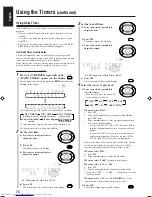
85
English
Aspect ratio
The ratio of horizontal and vertical sizes of a displayed image. The
horizontal vs. vertical ratio of conventional TVs is 4:3 and that of
wide-screen TVs is 16:9.
Component video signal
A video signal system where elements necessary for reproducing
image signal comprised of the three primary colors of light are
transmitted via separate signal lines. Types of signal, such as R/G/
B, Y/P
B
/P
R
, etc., are available.
Composite video signal
A video signal comprised of three kinds of signals combined: an
image signal made up of luminance and chrominance signals
using the frequency multiplication technique, burst signal
providing the basis for color reproduction, and synchronization
signal.
Dolby Digital
This is a digital audio compression technology that was developed
by Dolby Laboratories. Dolby Digital encoding method (so-called
discrete 5.1 channel digital audio format) records and compresses
the left front channel, right front channel, center channel, left rear
channel, right rear channel, and LFE channel (total 6 channels, but
LFE channel is counted as 0.1 channel, therefore called 5.1
channels) signals digitally. Each channel is completely
independent from other channel signals to avoid interference,
therefore, you can obtain much better sound quality with stereo
and surround effects.
Dolby Pro Logic
Dolby Surround encoding format records the left front channel,
right front channel, center channel, and surround channel
(monaural) signals into 2 channels.
DTS Digital Surround
Another discrete 5.1 channel digital audio format, available on
CD, LD, and DVD software, developed by Digital Theater
Systems, Inc.
Compared to Dolby Digital, audio compression rate is relatively
low. This fact allows DTS Digital Surround format to add breadth
and depth to the reproduced sounds. As a result, DTS Digital
Surround features natural, solid and clear sound.
Interlaced scanning
In the conventional video system, a picture is shown on the
display monitor in two halves. The Interlaced scanning system
places lines of the second half of the picture in-between lines of
the first half of the picture.
JPEG
A still-picture data compression system proposed by the Joint
Photographic Expert Group, which features little distortion in
image quality in spite of its high compression ratio.
Letter box
A method of displaying wide images like movies in on a 4:3 TV
screen with no part of the image deleted by placing black bands on
the top and bottom of the screen. This name has derived from the
screen form looking literally like a letter box.
MP3
A file format with a sound data compression system. “MP3” is the
abbreviation of Motion Picture Experts Group 1 (or MPEG-1)
Audio Layer 3. By using MP3 format, one CD-R or CD-RW can
contain about 10 times as much data volume as a regular CD can.
Multi-angle
By recording multiple scenes progressing at the same time in a
single title, the user can select view angles. This feature is called
the multi-angle function.
Multi-channel
DVD VIDEO has been designed to have each soundtrack
constitute one sound field. Multi-channel refers to a structure of
sound tracks having three or more channels.
Multi-language
When a title is created to cope with multiple languages, it is
generally called a multilanguage title.
Playback control (PBC)
Refers to the signal recorded on SVCD/VCD for controlling
reproduction. By using menu screens recorded on SVCD/VCD
that supports PBC, you can enjoy interactive-type software as well
as software having a search function.
Progressive scanning
By progressive scanning, all the horizontal lines of a picture are
displayed at one time as a single frame on a TV compatible with
NTSC color system. This system can convert the interlaced video
from DVD VIDEO into progressive format for a progressive TV. It
dramatically increases the vertical resolution.
Region code
A system for allowing discs to be played only in the regions
designated beforehand. All the countries in the world are divided
into six regions and each region is identified by a specified region
code (or region number). If the region code of a disc matches to
that of a player, the player can play back the disc.
Sampling frequency
Frequency of sampling data when analog data is converted to
digital data. Sampling frequency numerically represents how
many times the original analog signal is sampled per second.
Transfer rate
The rate of transferring digital data. Usually the measure is in bit
per second (bps). The DVD system applies a variable transfer rate
system for high efficiency.
Glossary
EN83-92_UX-J99DVD[UB]5.p65
03.12.12, 11:06 PM
85









































